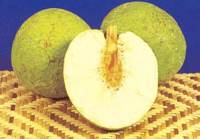THE African Cultural and Development Association (ACDA) promoted breadfruit as the main dish at the 174th Emancipation celebration at the National Park this year.  Sister Clementine Marshall, Chairperson and Cultural Coordinator of ACDA, indicated to the Guyana Chronicle that of all the items and foods available to that body this year, the association set out to promote breadfruit as the main dish, and to demonstrate its different recipes.
Sister Clementine Marshall, Chairperson and Cultural Coordinator of ACDA, indicated to the Guyana Chronicle that of all the items and foods available to that body this year, the association set out to promote breadfruit as the main dish, and to demonstrate its different recipes.
She noted that the plantation owners back in the time of slavery fed the slaves with breadfruit, since it was cheap and nutritious; and the slaves ate and felt satisfied, and had no complaints.
Marshall highlighted that breadfruit is today cheaper than English potatoes, and can be used in a number of ways, which her association will be promoting throughout the month of August.
HISTORY OF THE FRUIT
Breadfruit (Artocarpus altilis) is a species of flowering tree in the mulberry family moraceae, growing throughout Southeast Asia and most Pacific Ocean islands.
Its name is derived from the texture of the cooked fruit, which has a potato-like flavour similar to fresh-baked bread.
Ancestors of the Polynesian Islands found the trees growing in the northwest New Guinea area around 3,500 years ago. They gave up the rice cultivation they had brought with them from Taiwan, and raised breadfruit wherever they went in the Pacific (except Easter Island and New Zealand, which were too cold).
Their ancient eastern Indonesian cousins spread the plant west and north through insular and coastal Southeast Asia. The breadfruit has, in historical times, also been widely planted in tropical regions elsewhere.
Breadfruit trees grow to a height of 85 feet (26m). The large and thick leaves are deeply cut into pinnate lobes. All parts of the tree yield latex, a milky juice which is useful for boat caulking.
Both male and female flowers grow on the same tree. The male flowers emerge first, followed shortly afterward by the female flowers, which grow into capitula capable of pollination just three days later. The pollinators are Old World fruit bats in the family pteropodidae. The compound, false fruit develops from the swollen perianth, and originates from 1,500-2,000 flowers. These are visible on the skin of the fruit as hexagon-like disks.
Breadfruit is one of the highest-yielding food plants. A single tree can produce in excess of 200 fruits per season. In the South Pacific, the trees yield 50 to 150 fruits per year. In southern India, normal production is 150 to 200 fruits annually.
Productivity varies between wet and dry areas. In the Caribbean, a conservative estimate is 25 fruits per tree. Studies in Barbados indicate a reasonable potential of 6.7 to 13.4 tonnes per acre (16-32 tonnes/ha).
The grapefruit-sized, ovoid fruit has a rough surface, and each fruit is divided into many achenes, each surrounded by a fleshy perianth and growing on a fleshy receptacle. Some selectively bred cultivars have seedless fruit.
Breadfruit can be eaten once cooked, or can be further processed into a variety of other foods. A common product is a mixture of cooked or fermented breadfruit mash mixed with coconut milk and baked in banana leaves. Whole fruits can be cooked in an open fire, then cored and filled with other foods, such as coconut milk, sugar and butter, cooked meats, or other fruits. The filled fruit can be further cooked so the flavour of the filling permeates the flesh of the breadfruit.
The Hawaiian staple food called poi, made of mashed taro root, is easily substituted or augmented with mashed breadfruit. The resulting ‘breadfruit poi’ is called poizulu. In Puerto Rico, it is called panapen or pana, for short. Pana is often served boiled with a mixture of sauteed bacalao (salted cod fish), olive oil and onions. It is also served as tostones or mofongo. In The Dominican Republic, it is known by the name buen pan or “good bread”.
Breadfruit is also found in Indonesia and Malaysia, where it is called sukun. In the South Indian state of Kerala and coastal Karnataka, especially on the sides of Mangalore, where it is widely grown and cooked, it is known as kada chakka or seema chakka and deegujje respectively. In Belize, the Mayan people call it masapan.




.jpg)









